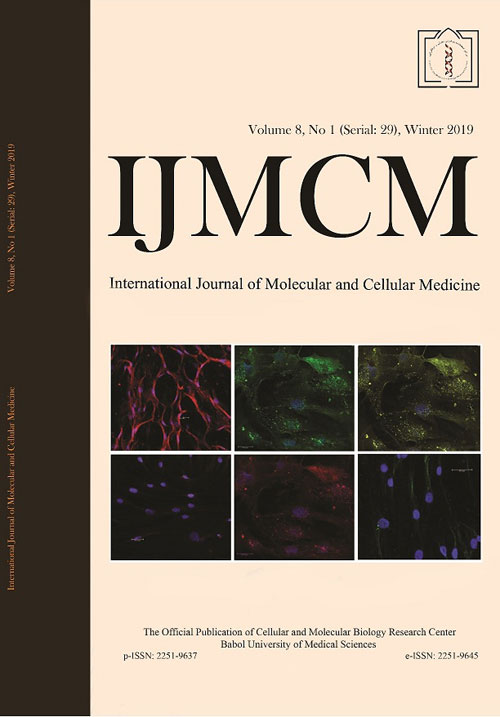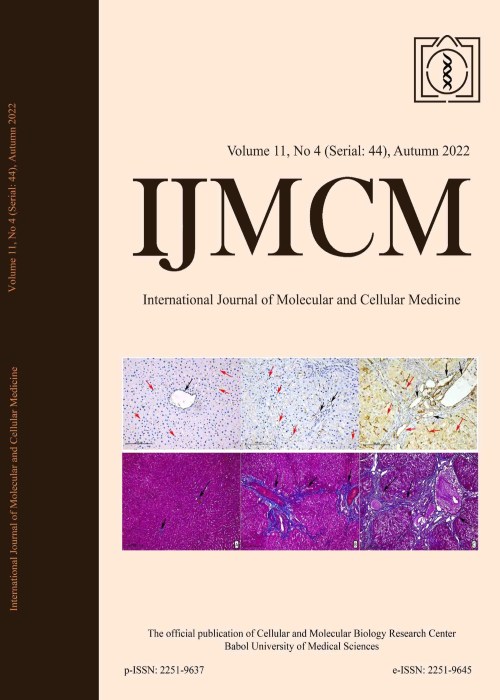فهرست مطالب

International Journal of Molecular and Cellular Medicine
Volume:8 Issue: 29, Winter 2019
- تاریخ انتشار: 1398/01/12
- تعداد عناوین: 8
-
-
Pages 1-13
The feasibility of isolating and manipulating mesenchymal stem cells (MSCs) from human patients provides hope for curing numerous disease and disorders. Recent phenotypic analysis showed heterogeneity of MSCs. A nestin progenitor cell is a subpopulation within MSCs which plays a role in pancreas regeneration during embryogenesis. This study aimed to separate nestin (+) cells from human bone marrow-MSCs, and differentiate these cells into functional insulin-producing cells (IPCs) compared with nestin (-) cells. Manual magnetic separation was performed to obtain nestin (+) cells from MSCs. Approximately 91±3.3% of nestin (+) cells were positive for the anti-nestin antibody. Pluripotent genes were overexpressed in nestin (+) cells compared with nestin (-) cells as revealed by quantitative real time-PCR (qRT-PCR). Following in vitro differentiation, flow cytometric analysis showed that 2.7±0.5% of differentiated nestin (+) cells were positive for anti-insulin antibody in comparison with 0.08±0.02% of nestin (-) cells. QRT-PCR showed higher expression of insulin and other endocrine genes in comparison with nestin (-) cells. While the immunofluorescence technique showed the presence of insulin and C-peptide granules in nestin (+) cells. Therefore, our results introduced nestin (+) cells as a pluripotent subpopulation within human MSCs which is capable to differentiate and produce functional IPCs.
Keywords: Human bone marrow derived mesenchymal stem cells, insulin producing cells, real time-quantitative PCR, mesenchymal stem cells, diabetes mellitus -
Pages 14-23
In vitro derivation of germ cells from different stem cells sources has been challenging in the treatment of male infertility. MicroRNAs (miRNAs) have an essential role in gene expression at post-transcriptional level. The aim of this research was to find more about miRNA-17 and miRNA-146 expression during differentiation of spermatogonial stem cell like cells (SSC like cells) from mouse bone marrow mesenchymal stem cells (BMSCs) through bone morphogenic protein 4 (BMP4) and retinoic acid (RA) induction. BMSCs were treated with BMP4 to produce primordial germ cell like cells (PGC like cells). The cells were differentiated into SSC like cells by an inducer cocktail including RA, leukemia inhibitory factor (LIF) and basic fibroblast growth factor (bFGF). The PGC like cells and SSC like cells were evaluated for pluripotency (Nanog, Oct-4) and germ cell specific gene (Piwil2, Plzf, Dazl, and Stra8) expression, protein expression (Plzf, Stra8), and miRNA-17 and miRNA-146 mRNA expression. Our results showed that BMP4 lead to Dazl up-regulation and Nanog down-regulation expression in PGC like cells. RA up-regulated Stra8 and Piwil2, and down-regulated Nanog and Oct-4. MiRNA-17 and miRNA-146 expression decreased significantly in SSC like cells after RA treatment. This research indicated the aberrant miRNA-17 and miRNA-146 expression in SSC like cells in comparison with SSCs. Down-regulation of the two miRNAs by using RA in the stimulated undifferentiated state could be probably one of the key factors of SSC like cells arrest.
Keywords: Bone marrow mesenchymal stem cells, spermatogonial stem like cells, differentiation, miRNA-17, miRNA-146 -
Pages 24-38
Nanofiber scaffolds and bio-ceramic nanoparticles have been widely used in bone tissue engineering. The use of human induced pluripotent stem cells (hiPSCs) on this scaffold can be considered as a new approach in the differentiation of bone tissue. In the present study, a polyaniline-gelatin-polycaprolactone (PANi-GEL-PCL) composite nanoscaffold was made by electrospinning and modified superficially by plasma method. The synthesized nanoscaffold was then coated with willemite's bio-ceramic nanoparticles (Zn2SiO4). The nanoscaffold’s properties were studied by scanning electron microscopy (SEM). Also, nanoparticles characterization was carried out with SEM and dynamic light scattering. The growth and proliferation rate of cells on the synthesized nanoscaffold was examined by MTT assay. Subsequently, hiPSCs were cultured on murine fibroblast cells, incubated in embryoid bodies for 3 days, and placed on the nanoscaffolds. The differentiation potential of hiPSCs was investigated by examination of common bone markers (e.g. alkaline phosphatase, calcium salt precipitation, and alizarin red test) using bone differentiation factors for 14 days. SEM showed the proper structure of electrospinned nanoscaffolds and coating of nanoparticles on the nanoscaffold surface. The results of MTT assay confirmed the growth and proliferation of cells and the biocompatibility of nanofibers. The results of bone indices also showed that differentiation on the composite nanoscaffold coated with willemite's bio-ceramic nanoparticles was dramatically increased in comparison with other groups. Overall, this study demonstrated that PANi-GEL-PCL composite nanoscaffold with willemite's bio-ceramic nanoparticles is a suitable substrate for in vitro growth, proliferation, and differentiation of hiPSCs cells into osteoblasts.
Keywords: Osteoblast differentiation, human induced pluripotent stem cells, poly-aniline-gelatin-polycaprolactone, Zn2SiO4 bio-ceramic nanoparticle -
Pages 39-54
The role of oxidized high-density lipoprotein (oxHDL) and the protective effects of adiponectin in terms of vascular calcification is not well established. This study was conducted to investigate the effects of oxHDL with regards to inflammation and vascular calcification and to determine the protective role of adiponectin in attenuating the detrimental effects of oxHDL. Cell viability, mineralization, and calcification assays were conducted to optimize the concentration of oxHDL. Then, human vascular smooth muscle cells (HAoVSMCs) were incubated with β-glycerophosphate, HDL, oxHDL, adiponectin, or the combination of oxHDL with adiponectin for 24 h. Protein expression of IL-6, TNF-α, osterix, RUNX2, ALP, type 1 collagen, osteopontin, osteocalcin, WNT-5a, NF-ĸβ(p65), cAMP and STAT-3 were measured by ELISA kits. OxHDL induced vascular calcification by promoting the formation of mineralization nodules and calcium deposits in HAoVSMCs. This was accompanied by an increased secretion of IL-6, osterix, WNT-5a and NF-ĸβ (p65). Interestingly, these detrimental effects of oxHDL were suppressed by adiponectin. Besides, incubation of adiponectin alone on HAoVSMCs showed a reduction of inflammatory cytokines, osteoblastic markers (RUNX2, osterix and osteopontin), WNT-5a and NF-ĸβ (p65). This study exhibits the ability of oxHDL in inducing inflammation and vascular calcification and these detrimental effects of oxHDL can be attenuated by adiponectin.
Keywords: HAoVSMCs, oxidized high-density lipoprotein, osteoblastic transdifferentiation, vascular calcification, adiponectin -
Pages 55-66
Conventional treatment for cancer such as surgical resection and chemotherapy can cause damage in cases with advanced cancers. Moreover, the identification of tumor-specific targets has great importance in T-cell therapies. For decades, T cell activity has been stimulated to improve anti-tumor activity. Bispecific antibodies have attracted strong interest from pharmaceutical companies, for their diagnostic and therapeutic use. Blinatumomab is a first-in-class bispecific T engager antibody for the treatment of relapsed or refractory precursor B- cell acute lymphoblastic leukemia. But, it can benefit several cases with CD19+ malignancies in the future. PhiC31 integrase-based vectors could selectively integrate therapeutic transgenes into pseudo-attP sites in CHO genome. In this study, production of Blinatumomab in CHO cells using this type of vectors was investigated. We evaluated the effects of histone deacetylases (HDACs) inhibitors such as sodium butyrate and valproic acid, on specific productivity and cell viability of antibody expressing cells. Although sodium butyrate increased specific productivity about 1.7-fold and valproic acid about 1.4-fold, valproic acid was found more efficient because of its less cytotoxic effect on cell growth. We examined the efficacy of expressed Blinatumomab at various effector to target (E/T) ratios. A dose-response analyses of calcein-acetoxymethyl release assay illustrated that the effective dose of expressed mAb required for antibody mediated cytotoxicity was 100 ng/ml and the expressed mAb was more effective at E/T ratios of 10:1 and 5:1. Results of this study indicated that the expressed blinatumomab can be useful for enhancing the cytotoxicity of CD3+ T-cells against CD19 + target cells in vitro.
Keywords: BiTE, T-cell activation, refractory acute lymphoid leukemia, therapeutic anti-CD19 mAb, Blinatumomab -
Pages 67-83
Genetic variations found in the coding and non-coding regions of a gene are known to influence the structure as well as the function of proteins. Serine palmitoyltransferase long chain subunit 1 a member of α-oxoamine synthase family is encoded by SPTLC1 gene which is a subunit of enzyme serine palmitoyltransferase (SPT). Mutations in SPTLC1 have been associated with hereditary sensory and autonomic neuropathy type I (HSAN-I). The exact mechanism through which these mutations elicit protein phenotype changes in terms of structure, stability, and interaction with other molecules is unknown. Thus, we aimed to perform a comprehensive computational analysis of single nucleotide polymorphisms (SNPs) of SPTLC1 to prioritize a list of potential deleterious SNPs and to investigate the protein phenotype change due to functional polymorphisms. In this study, a diverse set of SPTLC1 SNPs were collected and scrutinized to categorize the potential deleterious variants. Our study concordantly identified 21 non-synonymous SNPs as pathogenic and deleterious that might induce alterations in protein structure, flexibility and stability. Moreover, evaluation of frameshift, 3’ and 5’ UTR variants shows c.*1302T>G as effective. This comprehensive in silico analysis of systematically characterized list of potential deleterious variants could open avenues as primary filter to substantiate plausible pathogenic structural and functional impact of variants.
Keywords: single nucleotide polymorphisms, computational, deleterious, variants, bioinformatics tools -
Pages 84-89
One explanation for why downstream gonadotropin protocol changes during IVF commonly arrive too late to have significant effects is that embryo development actually begins during oogenesis. Thus, efforts to modify the chromosomal status of blastocysts must address the ovarian milieu well in advance of follicular recruitment. A 42 years old woman with primary infertility of 3 years duration attended with her partner. Five previous IVF cycles had produced 20 embryos, but all had genetic abnormalities and no embryo transfer was performed. Karyotypes and all lab tests were normal for both partners. 3 months before her IVF here, she received isolated platelet-derived growth factors injected into both ovaries as a cell-free, enriched substrate. Genetic assessments were via whole genome amplification and DNA tagmentation and PCR of adapter sequences. The comprehensive chromosomal screening was carried out by dual-indexed sequencing of pooled libraries on the MiSeq™ platform. From this IVF cycle one euploid 46, XY blastocyst was produced and vitrified on day of trophectoderm biopsy. 9 days after frozen embryo transfer, serum human chorionic gonadotropin was 250 mIU/ml and transvaginal ultrasound at 6 weeks gestation confirmed a single intrauterine pregnancy with a fetal heart at 153/min. Mother and baby continue to do well. While cellular and molecular events directing the oocyte-to-embryo transition are incompletely characterized, processes related to ovarian stem cell differentiation, mitochondrial dynamics, and mRNA storage, translation, and degradation likely are relevant. It appears that intraovarian application of autologous platelet-derived growth factors, when used before IVF, can impact oocyte integrity and facilitate euploid blastocyst development. Although research on intraovarian injection of autologous activated platelet-rich plasma has already shown improved quantitative IVF responses, this is the first description of qualitative improvements in embryo genetics after intraovarian injection of autologous platelet-derived growth factors.
Keywords: Reproductive outcome, cytokines, ploidy, blastocyst -
Pages 90-93
Myasthenia Gravis (MG) is a neuromuscular junction disorder caused by pathogenic autoantibodies to some parts of the post-synaptic muscle endplates. About 85% of generalized MG patients have autoantibodies against post-synaptic acetyl-choline receptors (AChR). From the 10-15% of the remaining patients, 45-50% are positive for Muscle Specific Tyrosine Kinase-Antibody (MuSK-Ab). It is believed that the thymus has a critical role in the pathogenesis of the disease with AChR-Ab, especially in patients with thymic abnormalities. In contrast, the role of thymus gland in MG with anti-MuSK-Ab is not clearly obvious. Patients with this antibody virtually have normal or only minimal follicular hyperplastic thymus. The presence of anti-MuSK Ab in a thymolipomatous (an uncommon tumor of thymus) MG is an atypical and new finding of MG because of not only thymolipoma but also presence of anti-MuSK antibodies which makes this case different from the previous reports of the antibodies-associated MG. Here, we present a young woman with thymolipoma and MG (a very uncommon kind of tumor-associated MG) and high level of anti-MuSK-Ab.
Keywords: Myasthenia gravis, thymolipoma, anti-acetylcholine receptor antibody, anti-Muscle Specific Tyrosine Kinase-Antibody


